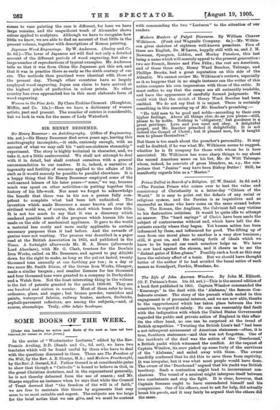Sir Henry Bessemer : an Autobiography. (Office of Engineering. 16s.
net.)—Sir Henry Bessemer died seven years ago, leaving this autobiography incomplete,—it ends, curiously enough, with an account of what we may call his "anti-sea-sickness steamship" experiment. The story is highly technical in character, and, we take it, not a little controversial. We shall not attempt to deal with it in detail, but shall content ourselves with a general recommendation to our readers. It is, indeed, a narrative of ingenuity and fertility of resource applied to the affairs of life such as it would scarcely be possible to parallel elsewhere. It is a happy thing that Sir Henry Bessemer employed some of the well-earned leisure of his later years—" some," we say, because much was spent on other activities—in putting together this history of his life-work. Nor must we forget to acknowledge the benefit that there was in his son a person fully com- petent to complete what had been left unfinished. The invention which. made Bessemer a name known all over the civilised world was, of course, the steel which bears this title. It is not too much to say that it was a discovery which rendered possible much of the progress which human life has made on the side of mechanical appliance. It gave to the world a material less costly and more easily applicable to certain necessary purposes than it had before. And the rewards of genius were not wanting. The process was described in a paper read at the British Association in 1855, and published in the Times. A fortnight afterwards Mr. H. A. Bruce (afterwards Lord Aberdare), with Mr. G. Clark, trustees for the Dowlais Iron Works, called on Mr. Bessemer, and agreed to pay £10,000 down for the right to make, as long as the patent lasted, twenty thousand tons annually at one farthing per ton ; in a day or two more Mr. Smith Dixon, of the Govan Iron Works, Glasgow, made a similar bargain ; and smaller licenses for ten thousand and four thousand tons were granted to a company in Derbyshire and a Welsh firm. Not the least interesting thing in the volume is the list of patents granted in the period 1838-83. They are one hundred and sixteen in number. Most of them refer to iron, ordnance, glass, and sugar ; but bronze powder, varnishes and paints, waterproof fabrics, railway brakes, anchors, firebricks, asphalt-pavement reflectors, are among the subjects,—and, of course, steamships. Truly, obv Zwapbs Betvorepor.


































 Previous page
Previous page